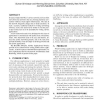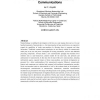47 search results - page 5 / 10 » Modeling TCAM power for next generation network devices |
WISEC
2010
ACM
14 years 2 months ago
2010
ACM
Computing environments on cellphones, especially smartphones, are becoming more open and general-purpose, thus they also become attractive targets of malware. Cellphone malware no...
WISTP
2010
Springer
14 years 2 months ago
2010
Springer
Widespread use and general purpose computing capabilities of next generation smartphones make them the next big targets of malicious software (malware) and security attacks. Given ...
CONEXT
2007
ACM
13 years 11 months ago
2007
ACM
In typical single-link 802.11 ad-hoc networks, devices often move from one network to the next, forming transitory associations without a fixed support infrastructure. The state i...
MOBIQUITOUS
2005
IEEE
14 years 1 months ago
2005
IEEE
Abstract— In future generation networks, various access technologies, such as Wi-Fi, Bluetooth, GPRS and UMTS, etc., are simultaneously available to mobile devices. They vary in ...
SECRYPT
2010
13 years 5 months ago
2010
Nanotechnology is enabling the development of devices in a scale ranging from one to a few one hundred nanometers. Nanonetworks, i.e., the interconnection of nano-scale devices, a...


